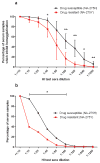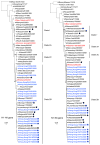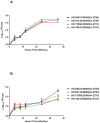The 2008-2009 H1N1 influenza virus exhibits reduced susceptibility to antibody inhibition: Implications for the prevalence of oseltamivir resistant variant viruses
- PMID: 22138712
- PMCID: PMC3243069
- DOI: 10.1016/j.antiviral.2011.11.006
The 2008-2009 H1N1 influenza virus exhibits reduced susceptibility to antibody inhibition: Implications for the prevalence of oseltamivir resistant variant viruses
Abstract
A naturally-occurring H275Y oseltamivir resistant variant of influenza A (H1N1) virus emerged in 2007, subsequently becoming prevalent worldwide, via an undetermined mechanism. To understand the antigenic properties of the H275Y variant, oseltamivir resistant and susceptible strains of H1N1 viruses were analyzed by hemagglutination inhibition (HI) and microneutralization assays. HI analysis with H1-positive sera obtained from seasonal flu vaccine immunized and non-immunized individuals, and H1-specific monoclonal antibodies, revealed that resistant strains exhibited a reduced reactivity to these antisera and antibodies in the HI assay, as compared to susceptible strains. Neutralization assay testing demonstrated that oseltamivir resistant H1N1 strains are also less susceptible to antibody inhibition during infection. Mice inoculated with a resistant clinical isolate exhibit 4-fold lower virus-specific antibody titers than mice infected with a susceptible strain under the same conditions. Resistant and sensitive variants of 2009 pandemic H1N1 virus did not exhibit such differences. While HA1 and NA phylogenetic trees show that both oseltamivir resistant and susceptible strains belong to clade 2B, NA D354G and HA A189T substitutions were found exclusively, and universally, in oseltamivir resistant variants. Our results suggest that the reduced susceptibility to antibody inhibition and lesser in vivo immunogenicity of the oseltamivir resistant 2008-2009 H1N1 influenza A virus is conferred by coupled NA and HA mutations, and may contribute to the prevalence of this H1N1 variant.
Copyright © 2011 Elsevier B.V. All rights reserved.
Figures




References
-
- Bright RA, Medina MJ, Xu X, Perez-Oronoz G, Wallis TR, Davis XM, Povinelli L, Cox NJ, Klimov AI. Incidence of adamantane resistance among influenza A (H3N2) viruses isolated worldwide from 1994 to 2005: a cause for concern. Lancet. 2005;366:1175–1181. - PubMed
-
- Bright RA, Shay DK, Shu B, Cox NJ, Klimov AI. Adamantane resistance among influenza A viruses isolated early during the 2005–2006 influenza season in the United States. JAMA. 2006;295:891–894. - PubMed
-
- Carr J, Ives J, Kelly L, Lambkin R, Oxford J, Mendel D, Tai L, Roberts N. Influenza virus carrying neuraminidase with reduced sensitivity to oseltamivir carboxylate has altered properties in vitro and is compromised for infectivity and replicative ability in vivo. Antiviral Res. 2002;54:79–88. - PubMed
Publication types
MeSH terms
Substances
Grants and funding
LinkOut - more resources
Full Text Sources
Research Materials

